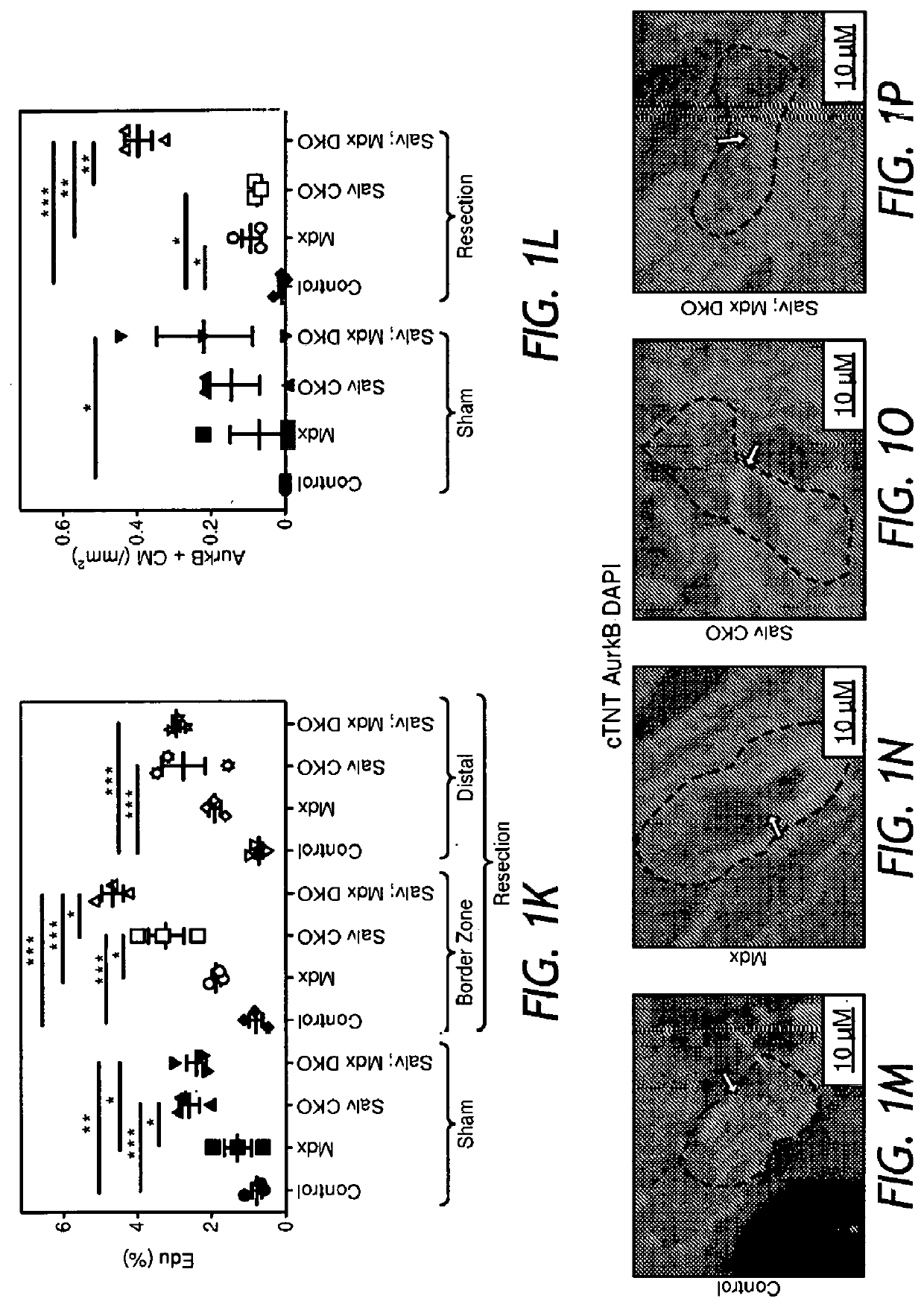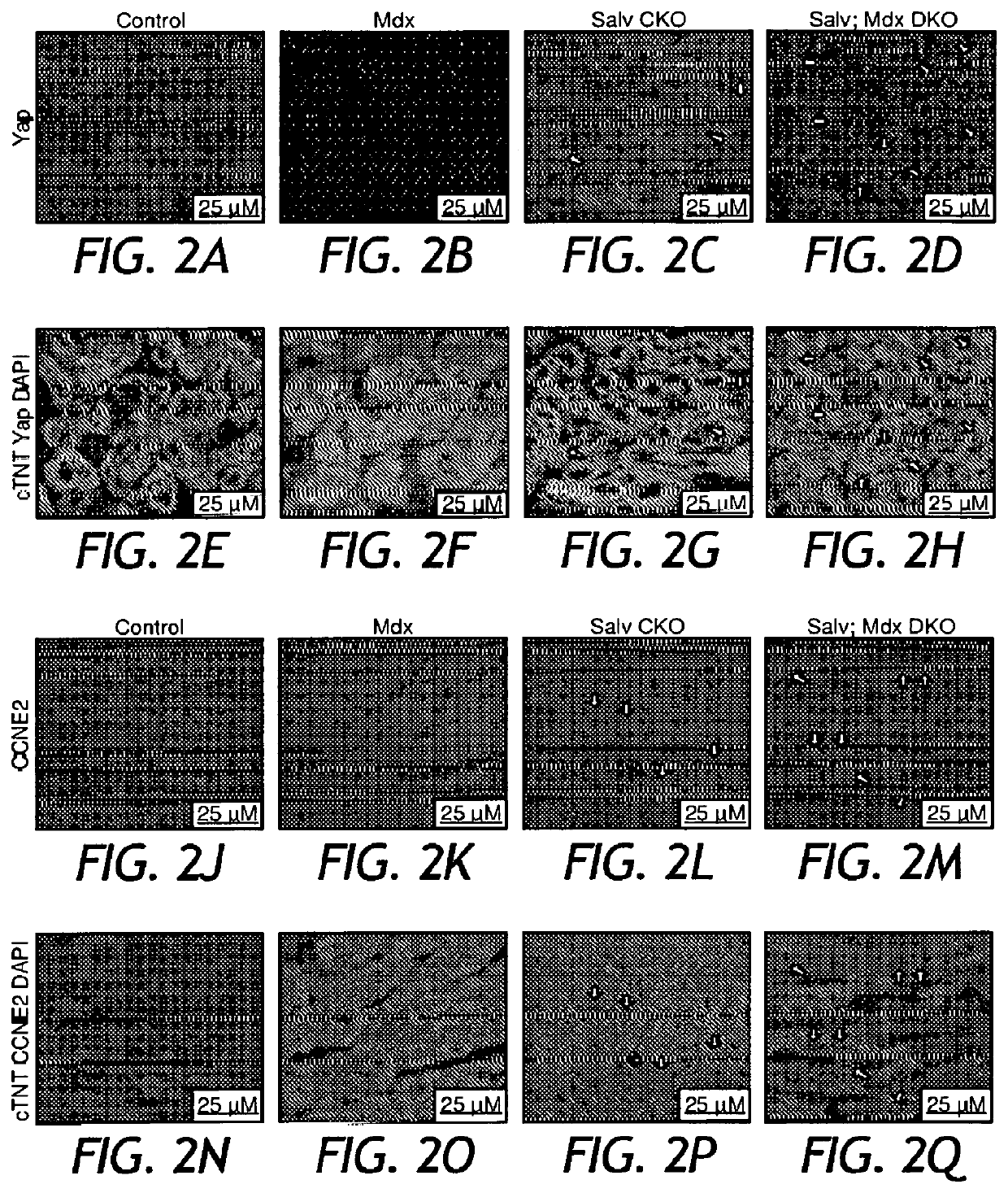Dystrophin glycoprotein complex sequesters yap to inhibit cardiomyocyte proliferation
a glycoprotein and yap technology, applied in the field of cell biology, molecular biology, physiology, medicine, can solve the problems of limited regenerative capacity of adult mammalian heart, and achieve the effect of inhibiting cardiomyocyte proliferation
- Summary
- Abstract
- Description
- Claims
- Application Information
AI Technical Summary
Benefits of technology
Problems solved by technology
Method used
Image
Examples
example 1
Dystrophin Glycoprotein Complex Sequesters Yap to Inhibit Cardiomyocyte Proliferation
[0096]Previous work revealed that DGC components are Yap targets6. To explore the connection between the Hippo pathway and DGC function, the inventors conditionally deleted the gene encoding the Hippo pathway component Salvador (Salv) in myocardium in an Mdx (dystrophin loss of function) background4,7. Neonatal cardiac apex resections were performed at nonregenerative postnatal (P) day 8, and resected hearts collected at P29 revealed that control and Mdx hearts failed to regenerate (FIGS. 1A, 1B, 1E, 1F, 1H), whereas Salv conditional knockout (CKO) hearts regenerated efficiently (FIGS. 1C, 1E, 1G). Remarkably, Salv;Mdx double knockout (DKO) hearts regenerated with excessive myocardial growth at the resection site, often with a completely formed secondary cardiac apex (FIGS. 1D, 1E, 1I, 1J). Both Salv CKO and Salv;Mdx DKO resected hearts had reduced scarring, indicating efficient cardiac repair (FIGS...
example 2
Examples of Materials and Methods
[0107]Mice. Control (Mhy6-Creert; mTmG), Mdx (Mdx;Mhy6-Creer;mTmG), Salv CKO (Salvfx / fx;Mhy6-Creert;mTmG), and Salv;Mdx DKO (Salvfx / fx;Mdx;Mhy6-Creert;mTmG) mice were used for genetic studies. For studies involving AAV9 infection, C57-BL / OScSn-Dmdmdx / J mice (The Jackson Laboratory, Bar Harbor, Me., USA) were used. Because the allele encoding dystrophin is X-linked, only male mice were used in this study. The gain-of-function transgenic Yap 5SA mouse line was created by injecting mice with the CAG-loxP-eGFP-Stop-loxP-Flag YAP2 5SA-IRES-βGal plasmid12. The sequence of Flag-YAP2 5SA was obtained from the pCMV-Flag YAP2 5SA plasmid (a gift from Kun-Liang Guan (UCSD), Addgene plasmid #27371). Mhy6-Creert mice were crossed with hemizygous Yap5SA mice. To induce the expression of Yap5SA in CMs, tamoxifen (150 mg) was injected daily for 4 days into 6-week-old Yap5SA;Mhy6-Creert mice.
[0108]For each experimental group, a minimum of 3 mice were studied that wer...
PUM
 Login to View More
Login to View More Abstract
Description
Claims
Application Information
 Login to View More
Login to View More - R&D
- Intellectual Property
- Life Sciences
- Materials
- Tech Scout
- Unparalleled Data Quality
- Higher Quality Content
- 60% Fewer Hallucinations
Browse by: Latest US Patents, China's latest patents, Technical Efficacy Thesaurus, Application Domain, Technology Topic, Popular Technical Reports.
© 2025 PatSnap. All rights reserved.Legal|Privacy policy|Modern Slavery Act Transparency Statement|Sitemap|About US| Contact US: help@patsnap.com



